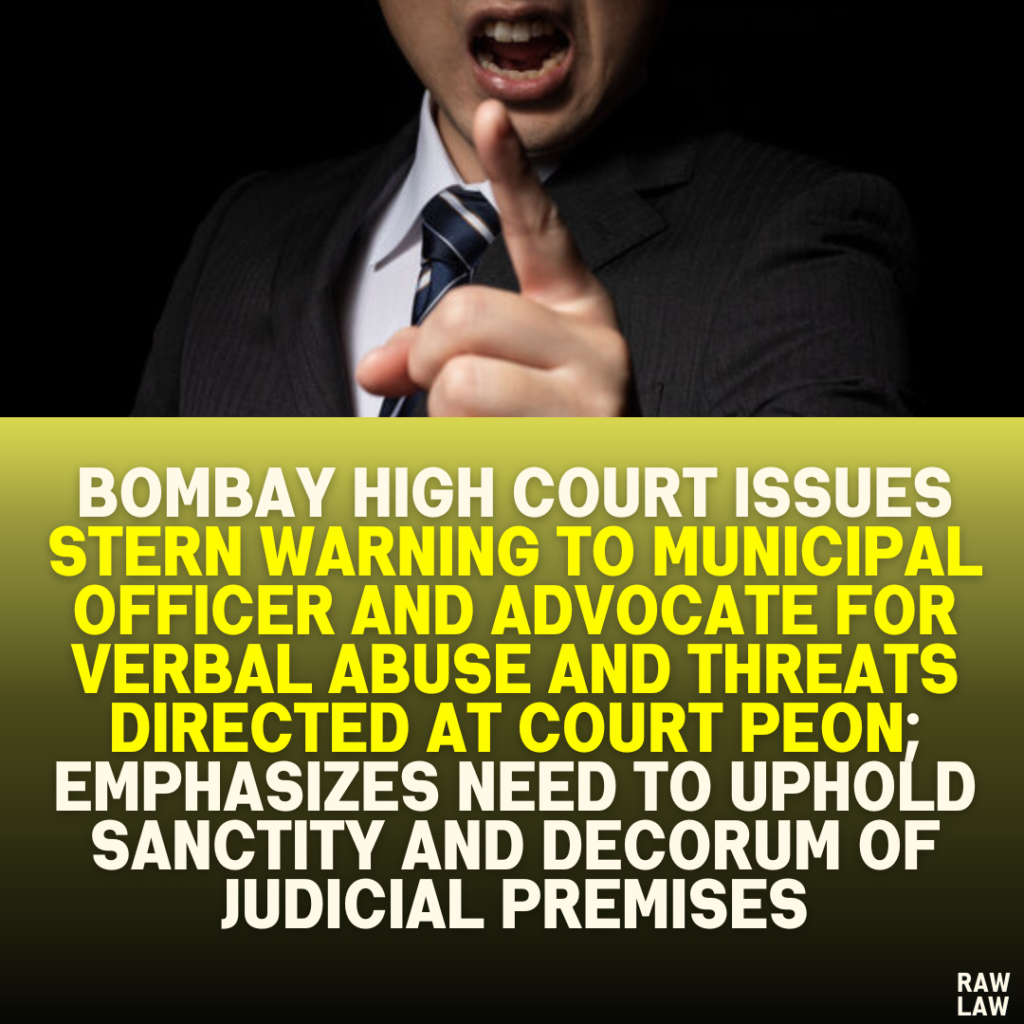Court’s Decision
The Bombay High Court, in a suo motu writ petition, addressed an incident of verbal abuse and threats directed at a court peon by a municipal officer and his advocate. The court accepted the unconditional apology tendered by the respondents but issued a strict warning to avoid any similar misconduct in the future. The petition was disposed of with the caution that the sanctity of court premises must always be maintained.
Facts
On November 14, 2024, during proceedings outside Court Room No. 53 of the Bombay High Court, a court peon, Mr. Atul D. Tayade, was carrying out his duty of maintaining peace and order in the corridors as per the court’s directions. Around 1:15 PM, Mr. Mayur Gulabrao Patil, identified as the Deputy Commissioner of the Nashik Municipal Corporation, accompanied by Advocate Mr. Dinesh Kadam, verbally abused and threatened the peon. The respondents used filthy language and warned the peon that they would report him to his appointing authority, leading to his dismissal by the end of the day.
The court consciously avoided reproducing the exact language used by the respondents to maintain decorum in the judicial record.
Issues
- Did the actions of the respondents violate the decorum expected within court premises?
- Should criminal charges or disciplinary action be pursued against the respondents for their conduct?
Petitioner’s Arguments
The court initiated the suo motu writ petition to address the reported misconduct and safeguard the integrity of court proceedings. The primary concern was to ensure that such behavior does not recur in any court in the state.
Respondent’s Arguments
- The advocate attempted to justify his actions initially but later acknowledged the gravity of the incident.
- Following interventions by senior legal professionals, both respondents submitted detailed affidavits, tendering unconditional apologies for their behavior. They assured the court that such incidents would not occur in the future.
Analysis of the Law
The court considered whether the respondents’ behavior could attract punitive action under the provisions of the Bharatiya Nyaya Sanhita (BNS) (akin to the Indian Penal Code). The court recognized that such acts of verbal abuse, physical threats, and attempts to intimidate a court officer could constitute criminal offenses. However, it refrained from taking strict punitive measures, noting the respondents’ apologies and the plea for leniency made by senior legal practitioners.
Precedent Analysis
Although no specific precedents were cited, the case was approached under general principles of judicial discipline and decorum. Courts have consistently emphasized that any form of misconduct or intimidation within court premises is unacceptable and punishable under the law. The Bombay High Court maintained these principles while balancing the potential consequences of stringent action on the respondents’ professional lives.
Court’s Reasoning
The court expressed its strong displeasure with the conduct of Mr. Patil and Mr. Kadam, emphasizing that such behavior undermines the dignity of judicial institutions. The judges initially considered instructing the peon to file a criminal complaint under the Bharatiya Nyaya Sanhita against both respondents. However, the intervention of Senior Advocate Mr. Ram Apte and Advocate Mr. Subhash Jha persuaded the court to consider a more measured response.
The court ultimately decided to accept the respondents’ unconditional apologies, submitted through notarized affidavits, as sufficient. However, it issued a strict caution, warning both individuals to ensure that such misconduct is not repeated.
Conclusion
The High Court accepted the unconditional apology of the respondents and disposed of the petition. The court warned the respondents to adhere strictly to professional and ethical standards and cautioned against any repetition of such behavior in court premises.
Implications
- For Legal Professionals: The judgment reinforces the obligation of legal professionals to uphold the dignity and decorum of judicial institutions. Misconduct within court premises, irrespective of professional standing, is unacceptable.
- For Judicial Proceedings: By addressing the issue suo motu, the court sent a strong message that any breach of decorum in judicial environments would be dealt with firmly, ensuring the safety and dignity of court staff and litigants.
- For Respondents: The respondents avoided criminal charges and disciplinary actions this time, but the court’s caution serves as a deterrent against future incidents.
- Broader Impact: This case underscores the judiciary’s balancing act between enforcing discipline and offering opportunities for rehabilitation when apologies are tendered in good faith. It highlights the judiciary’s role in maintaining respect and order within its precincts, serving as a reminder to all stakeholders to adhere to the highest standards of conduct.




Pingback: Delhi High Court Dismisses Petition Challenging Reclassification of Handicraft Exports: "MEIS Benefits Were Not Available for Goods Incorrectly Classified Under ITC(HS); Misclassification Violates Customs Act Sections 28 and 28AAA" - Raw Law
Pingback: Delhi High Court: Consent Under Section 17(5) of Customs Act Binds Importers to Enhanced Valuation—"When Importers Voluntarily Consent, Customs Authorities Are Not Required to Conduct Further Investigations or Issue Speaking Orders" - Raw Law